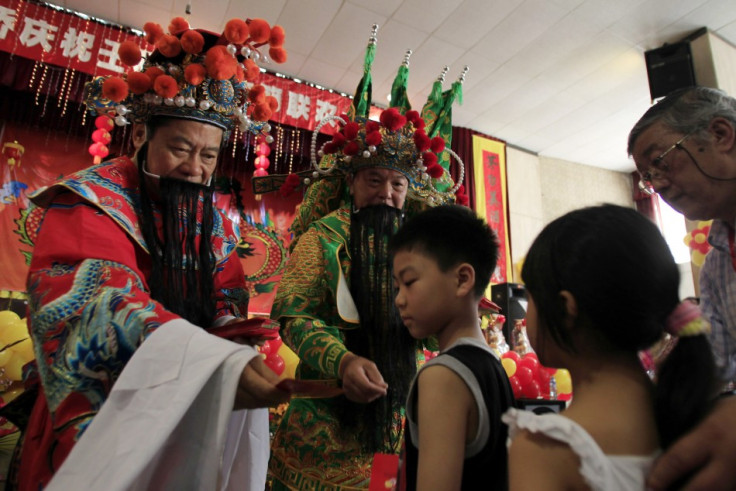Chinese New Year 2016: What is the traditional meaning of giving red packets?

Giving red packets wishes good luck, and putting money in the envelopes is to bring happiness, welcoming in the Year of the Monkey. In China, the vivid red and gold packet is called yasui qian (supressing ghosts money), or referred to as Lai See in Hong Kong.
The red packets are usually given to the younger generation by their parents, grandparents and other relatives, and it is considered rude to open the envelope in front of the person who has given it to them. For Chinese, the colour of red symbolises energy, good fortune and to ward off evil spirits.
It is traditional to give the packets after the New Year's Feast or they can be put under children's pillows when they fall asleep, to be opened to welcome in the morning.
According to custom, once people have started earning money, it's time to give red packets to the younger generation. But for those who are not married, it's not considered necessary to give money. There is also a widespread tradition that money should not be given in fours, or the number four should not appear in the amount, such as in 40, 400 and 444, as the pronunciation of the word "four" sounds similar to the word "death".

In China, during the Qin Dynasty, elders would thread coins with a red string. The money was referred to as "money warding off evil spirits" (yasui qian) and was believed to protect from sickness and death.
The yasui qian was replaced by red envelopes when printing presses became more common and is now found written using the similar-sounding word for suì that means "old age" instead of "evil spirits" thus, "money warding off old age".
In the run-up to Chinese New Year, hundreds of people queued up outside an HSBC branch in Hong Kong, wanting crisp new dollar bills to stuff in red envelopes for the Lunar New Year. Some arrived as early as 6.30am, prompting the bank branch to start service at 7.30am, an hour earlier than its usual opening time.
The red envelope is offered to children and employees during the first two weeks of the Lunar New Year, with a HK$20 note the average amount given. Retired public servant Kate Fung said she would still give away thousands of dollars in lai see money this year, the same amount as in previous years.
"Those who are still working might be affected by the economic downturn, but for us, it hardly has any impact," she told the South China Morning Post.
Ghost story
There are several legends as to how the red envelope tradition became prevalent in China. One story tells of a village where a demon was terrorising the people at night, with children as its victims. The belief was that the demon was touching the children's head while they were asleep and this would cause the children to become mortally ill and die.
A concerned couple decided to protect their new-born child by praying to the gods for protection. In return, a deity sent eight fairies to protect the newly born child from the demon. In order to trick the demon, the fairies disguised themselves as eight coins and were placed under the child's pillow at night to protect the child.
At night the devil came in to touch the child on the head when the eight coins began to shine so brightly, preventing the beast from seeing. It then ran away in terror. After hearing this story, the villagers began spreading the word and gave out red envelopes filled with coins to be placed under their pillow at night.
At first, the red envelopes were only given to children during the Spring Festival, but as time went on, they were given to family and friends.
© Copyright IBTimes 2024. All rights reserved.









